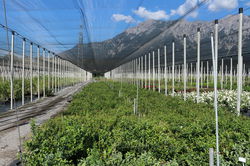 As in other fruit and berry species, the blueberry assortment is still largely dominated by varieties bred for commercial cultivation. At the same time as the unstoppable rise of blueberries, which are the second most important berry fruit in professional cultivation after strawberries, breeding has also intensified, but it is rather unlikely that the home garden market will be able to profit from this as it has in the past. Most new varieties for domestic horticulture are proprietary, which means that they are not only protected by variety and/or trademark laws, but are only left to certain growers and vertically integrated fruit suppliers for cultivation. Nevertheless, it is worth taking a first look at the current trends in commercial cultivation before we describe some of the main focuses of breeding blueberries for the home garden.
As in other fruit and berry species, the blueberry assortment is still largely dominated by varieties bred for commercial cultivation. At the same time as the unstoppable rise of blueberries, which are the second most important berry fruit in professional cultivation after strawberries, breeding has also intensified, but it is rather unlikely that the home garden market will be able to profit from this as it has in the past. Most new varieties for domestic horticulture are proprietary, which means that they are not only protected by variety and/or trademark laws, but are only left to certain growers and vertically integrated fruit suppliers for cultivation. Nevertheless, it is worth taking a first look at the current trends in commercial cultivation before we describe some of the main focuses of breeding blueberries for the home garden.
Blueberry breeding for commercial cultivation
For almost the entire 20th century (the cultivated blueberry is not older than that), the blueberry assortment was dominated by American growers, most of whom worked at universities and at the USDA (United States Department of Agriculture).

Picture: Frederick Vernon Coville, the inventor and first breeder of the cultivated blueberry (Source: Wikipedia®)
In the north and northeast part of the United States, Vaccinium corymbosum was the main cultivar for cultivated blueberries; in the south, especially in Florida, an additional group of cultivated blueberries was bred around Vaccinium ashei, a little later, from the middle of the 20th century, which requires less winter cold and produces qualities and fruit sizes similar to those of the northern cultivated blueberries. In the last 30 years, however, the blueberry production itself has also globalised breeding, and considerably more than 60% of the new varieties are evergreen or semi-evergreen varieties for growing in the southern hemisphere with little or no winter hardiness. The expansion of blueberries is taking place in the south; off season in the north there are big market gaps and new varieties are being bred exactly for this. And when the Asians and Chinese also start eating blueberries then the production and sales will explode again. By the way, this market development can also be seen in newer varieties for commercial cultivation, which are often extremely sweet and get by with little acidity – which is perfect for the Asian market. These varieties are then per se relatively unsuitable for the Central European home garden (due to lack of winter hardiness, evergreen plants, the flavour is only sweet), and in addition, as already mentioned above, there is a tendency towards proprietary varieties (often also called club varieties), which are also not freely licensed.
The tendency of breeding for commercial cultivation is towards yield optimisation, machine-pickable varieties, significantly improved fruit size, together with a very firm and crisp texture. A central goal in both breeding and quality assurance in commercial cultivation is continuous good quality; this regularity and consistency is still not satisfactory. New varieties are also bred for this purpose, whose fruits are much more uniform and also much firmer.
Five principles for breeding blueberries for the home garden
Blueberry breeding for the home garden market is absolutely necessary if innovations are to take place here as well. As mentioned above, the progress of the varieties for the market garden is not expected to come from commercial cultivation. I see five directions of blueberry breeding for the home garden.
More robust blueberry varieties
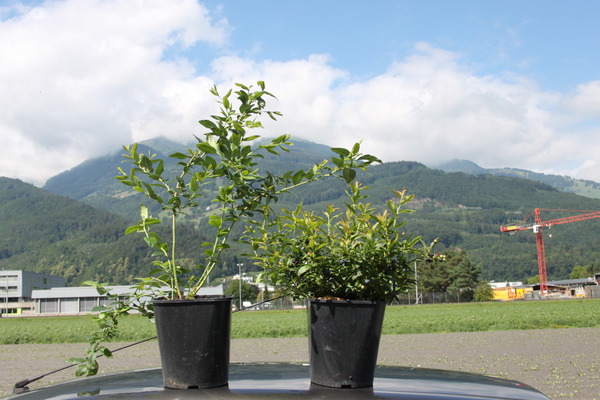
Picture: different grow habits out of the same crossing
I believe that we have enough semi-evergreen varieties in our assortment and that we should not expand this segment any further. The customer wants to plant, harvest and enjoy. He/she rarely feels like “protecting and caring for” the plants. This means that we will have to concentrate more on the northern blueberries again. Vaccinium angustifolium and Vaccinium corymbosum as well as related species still offer many possibilities.
Beautiful varieties
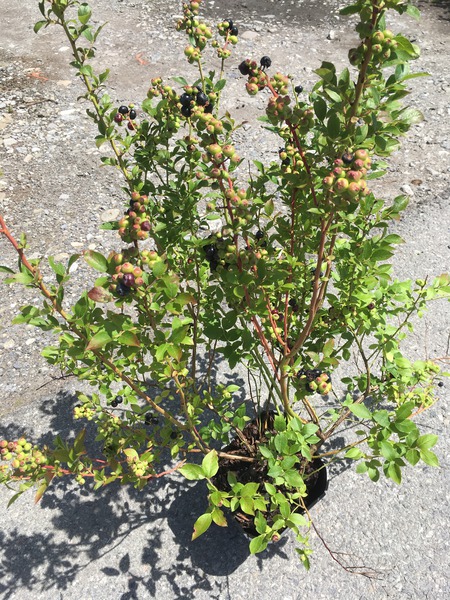
Picture: blueberry selection with black fruits
Without breeding in southern varieties, it will be more difficult to breed ornamental varieties. It is the southern species and varieties that often bring beautiful foliage. However, much can still be achieved with the growth habit. There are hardly any really compact, high-yielding, good-tasting and hardy varieties on the market. We also see variety candidates in our breeding pipeline that are suitable for growing as a ground cover or a hanging plant. It is also not God-given that blueberry fruits always have to be blue-frosted; there are also other colour shades that are possible here: e.g. dark blue to black, or pink.
Better varieties
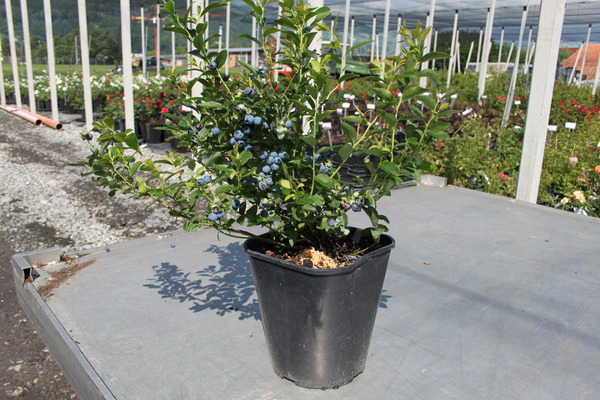
Picture: compact blueberry selection with fruits
For a long time, blueberries have been perceived as blueberries and the differences in taste have hardly been discussed. It is one of the success characteristics of blueberries that they taste right through the middle; everyone likes the fact that there is hardly any objection. There is sweetness; there is juice and some aroma. Above all, there's nothing that would offend anyone and there is nothing that attracts negative attention. But there is still a lot of room for improvement: above all, the intensity of the aroma but also the fruitiness can be greatly enhanced. Together with a crisp, relatively firm bite and a fine texture, this results in a much better eating experience.
Simpler varieties: convenience
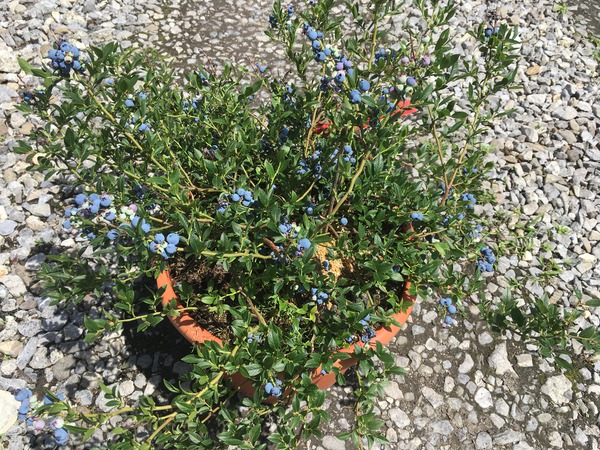
Picture: reblooming blueberry in selection progress
I particularly see possibilities here in the growth and in the cultivation tips and pruning instructions resulting from it. The old dream of pH tolerance will be difficult to achieve, otherwise we would have had such varieties long ago. In the breeding direction towards “convenience”, I would also include double-bearing varieties that bloom twice: it is really easier to harvest two times from one plant instead of having to plant two shrubs with different ripening times. Also the ornamental value of the twice-bearing varieties is of course significantly improved: double flowering and two times blue are certainly better than just one time...
Blueberry breeding at Lubera®
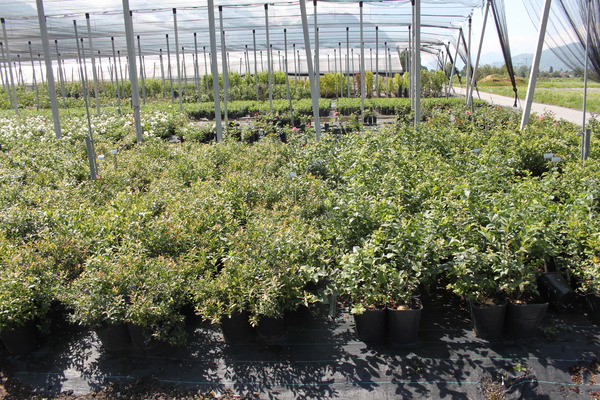
Picture: blueberry breeding at our sister company Lubera®
At Lubera® we only started breeding blueberries a few years ago, i.e. relatively late. We mainly concentrate on northern, hardy Vaccinium species and we try to gain improved home garden varieties through new combinations. We see clear progress in the early ripening period and in the quality, but also in the different types of growth. In the enhancement and improvement of the reblooming character (twice-bearing varieties) we see a further focus of our breeding efforts. In the meantime, we have selected around 50 parents with such traits and have already reached the second and third crossings. Everbearing and twice-bearing blueberry varieties will become reality! But for this they must be much earlier in the first harvest and the post-flowering must take place immediately after the harvest. These are precisely the selection criteria that we pursue when breeding blueberries that have a second bloom and this is where we are also making great progress.
Click here for more information.
Would you like more information, an individual consultation or information about additional ranges?
Click here for the complete 2019 catalogue, which can be downloaded.
If you have specific questions, please do not hesitate to contact our customer service, where you can also spontaneously place an order.
And of course we are always there for you via telephone.
If you want to be regularly informed about news, etc., you can also subscribe to our gardener newsletter here, which we send out about once a month - it's worth it!
